-
14
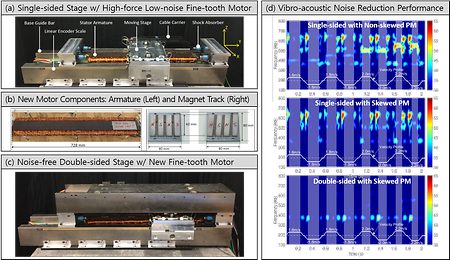
- Novel Motor for Next-Generation Semiconductor Photo-Lithography Systems
- Novel Motor for Next-Generation Semiconductor Photo-Lithography Systems Professor Jun Young Yoon in the Department of Mechanical Engineering at Yonsei University has worked with MIT researchers to design and develop a new motor for high-precision high-throughput next-generation EUVL (Extreme Ultra-Violet Lithography) systems. While commercially available linear iron-core synchronous motors have the potential for high thrust, they can emit significant vibrations and acoustic noise, thereby impairing accuracy of high-precision manufacturing systems such as in photo-lithography machines, also known as semiconductor chipmakers. Professor Yoon and his co-workers 1) found, for the first time, root causes of such vibro-acoustic noise emitted by linear iron-core permanent magnet motors, 2) proposed and validated a new motor magnetic design, called a fine-tooth motor, to reduce the noise while increasing thrust performance compared with conventional linear motors, and 3) further reduced the noise through a double-sided mechanical configuration of the new fine-tooth motors. The work has been published in multiple journals and conferences including IEEE Transactions on Industrial Electronics (TIE) and IEEE/ASME Transactions on Mechatronics (TMECH). For his research accomplishment, Professor Yoon won the ‘Young Engineer Award’ from the Korean Society for Precision Engineering (KSPE) and the ‘Young Scientist Award’ in the 2019 ASML Korea Tech Talk, which is also covered in media (links provided below). “We hope our new magnetic and mechanical solutions of high-force low-noise linear motors for the EUVL help the semiconductor industry pushing the limits even further to make our everyday lives faster, easier, and smarter“, says Professor Yoon. [Associated Publication] Yoon, J.Y., Lang, J.H. and Trumper, D.L., Fine-tooth iron-core linear synchronous motor for low acoustic noise applications. IEEE Transactions on Industrial Electronics, doi: 10.1109/TIE.2018.2835416 Yoon, J.Y., Lang, J.H. and Trumper, D.L., Double-Sided Linear Iron-Core Fine-Tooth Motor for Low Acoustic Noise and High Acceleration. IEEE/ASME Transactions on Mechatronics, doi: 10.1109/TMECH.2019.2929236 [Media Coverage] THEELEC: http://www.thelec.kr/news/articleView.html?idxno=2751 KIPOST: https://www.kipost.net/news/articleView.html?idxno=201782
- 기계공학부 2020.08.26
-
13

- Vibration & sound power reduction of a thin plate-like structure excited by complex inputs
- Vibration & sound power reduction of a thin plate-like structure excited by complex inputs Many engineering structures are composed of plates and plate-like components, such as the outer casing of a washing machine, printed circuit boards (PCBs) in electronic devices, the ship hull and deck. These structures are vulnerable to complex inputs, combination of force and moment components, from vibrational sources such as motors, pumps, and collision between parts. The resulting vibration and noise emissions jeopardize the integrity of the engineering structure. Yonsei research team led by Professor No-Choel Park in the school of Mechanical Engineering proposed a new method for reducing the vibration and sound radiation of a thin plate excited by complex input sources. A set of new formulas for the sound radiation of baffled and unbaffled plates are derived by substituting the moment components of the plates with the equivalent couples using finite difference analysis. This approach allows to calculate sound power purely by the input location and amplitude of each component. Thus, it enables faster, more accurate calculations than the existing methods such as the average radiation efficiency analysis and the radiation mode analysis. The results of the research were published in Journal of the sound and vibration with the title “Calculation and reduction of sound radiation from a thin plate structure excited by complex inputs”.
- 기계공학부 2020.08.26
-
12
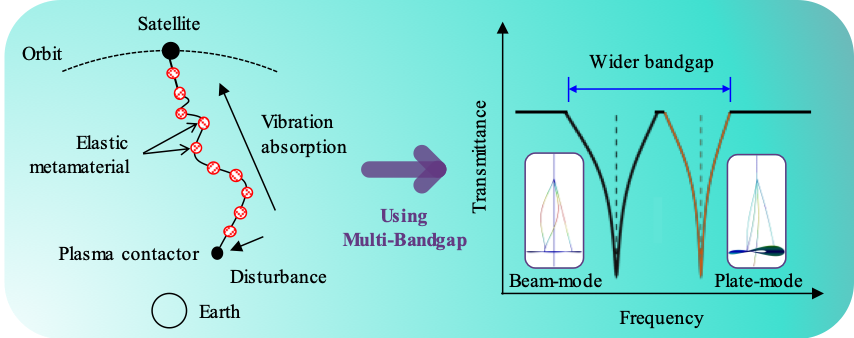
- Vibration absorption of space tethers using pendulum-type elastic metamaterial
- Vibration absorption of space tethers using pendulum-type elastic metamaterial Professor No-Cheol Park in Mechanical Engineering and his research team have designed pendulum-type elastic metamaterials for vibration absorption of space tethers. Space tether is highly exposed to external disturbances such as meteoroid collisions. Disturbances are transmitted to the satellite via tether cables and affect the satellite's orbit and posture. The pendulum-type elastic metamaterial absorbs vibration propagating through the resonance of the internal structure. In addition, his research team proposed a method to absorb vibrations over a wider frequency range using multi-bandgaps. The results of the research were published in the International Journal of Mechanical Sciences in July 2020 with the title “Experiment and analysis of a space tether with pendulum-type elastic metamaterials” and Korea patent with the title “Satellite tether device using elastic metamaterial” has been registered.
- 기계공학부 2020.08.26
-
11

- Replacing batteries with supercapacitors
- Most batteries we use on a daily basis are rather inefficient. Rechargeable lithium batteries – like the one on your phone – take long to recharge and have short cycling lifetimes. This is detrimental to the environment and ultimately expensive. Supercapacitors have the ability to store static electricity between two oppositely charged plates, and they have the benefit of being faster and more durable. However, the energy density (or amount of energy that can be stored per unit volume) of most supercapacitors is still considerably lower than most batteries. This is related to the capacitance of the supercapacitor, which depends on the material of the electrodes. Researchers have experimented with negative electrodes made of molybdenum dioxide (MoO2) nanostructures, which could provide a high specific capacitance, but these are limited by slow kinetics and volume change upon cycling. This impedes electrochemical stability and leads to rapid degradation upon cycling. Rechargeable batteries degrade rapidly, charge slowly, and have harmful environmental consequences. This is why supercapacitors could be the next big revolution in electronics. (Photo courtesy: Shutterstock) To solve this problem, a group of researchers led by Prof. Seong Chan Jun, have designed a tubular nanostructure of MoO2 combined with nitrogen-doped carbon hybrids (MoO2@NC) as the negative electrode. The hollow nature of the structure provides a higher surface-to-volume ratio for the charge to distribute, enhancing its electrochemical performance. At the same time, the N-doped carbon enhances the electrolyte transportation of the material. This was synthesized along with a copper cobalt sulfide (CuCo2S4) structure as the positive electrode to complete the supercapacitor. This resulted in a supercapacitor that performed significantly better than those previously reported in the literature. The flexible, hollow carbon substrate provided a large surface area that was also better able to alleviate volume change during cycling, improving electrical conductivity. The structure achieved what the author Prof. Jun described as an “ultrahigh”energy density of 65.1 W h kg -1 at a power density of 800 W kg -1. Approximately 90.6% of the initial specific capacitance was retained after 5000 cycles, and after 2000 bending cycles, the device exhibited 92.2% retention. “Developing more efficient ways to store energy could significantly change the way we interact with electronics”, says Prof Jun. Flexible supercapacitors could make wearables more user-friendly. They are better for the environment, and lighter in weight. Because they can deliver and accept significantly faster than batteries, affordable and smaller supercapacitors have the potential to change the electric car industry. Link to the paper Updated in August 2019
- 기계공학부 2020.06.27
-
10
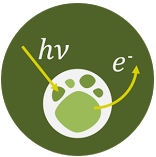
- Nanoelectrode System Developed to Extract Electricity from Algae
- A research team led by Professor Won-Hyoung Ryu has created a technology to extract photosynthetic electrons from algae Yonsei Mechanical Engineering Professor Won-Hyoung Ryu’s research team has created a technology to extract photosynthetic electrons from algae. Their method involves inserting a patterned nanowire or nanoelectrode into live algal cells, enabling the potential harvesting of electricity from multiple cells simultaneously. The team reported on this new energy conversion technology in the September 14, 2016 issue of Advanced Functional Materials, an important journal in the field of materials engineering. Of the research, Professor Ryu said: “The system we developed this time is a new concept of bio-solar energy conversion technology that uses algal cells, which have recently come to the fore as an environmental issue. This technology’s development is the product of a study that showed the possibility of the practical use of photosynthetic currents, and it further shows the possible development of bio-solar energy hybrid energy conversion technology.” Updated in Feb 2017 Reference Kim, L. H., Kim, Y. J., Hong, H., Yang, D., Han, M., Yoo, G., Song, H. W., Chae, Y., Pyun, J.-C., Grossman, A. R., Ryu, W., “Patterned Nanowire Electrode Array for Direct Extraction of Photosynthetic Electrons from Multiple Living Algal Cells” Advanced Functional Materials, doi: 10.1002/adfm.201602171
- 기계공학부 2020.06.27
-
9
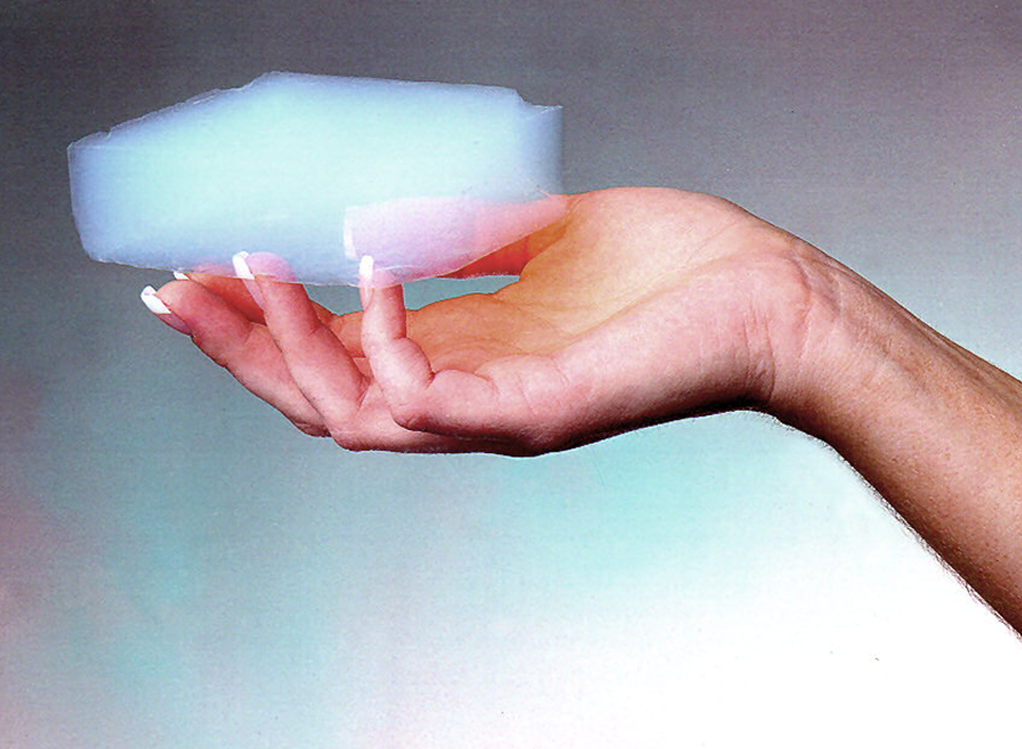
- Artificial materials for developing low-cost optical devices
- New research demonstrates macroscale materials having optical properties that are modifiable by mechanical compression, paving the way for industrial-scale production of advanced optical devices. The study—“Scalable variable-index elasto-optic metamaterials for macroscopic optical components and devices”—published in Nature Communications was carried out by a group of researchers including Dr. Kyoungsik Kim of Yonsei University. They developed a method to build large, low-cost, and mass-producible advanced optical devices by using an artificial material called “metamaterial” that changes its refractive index when subjected to mechanical stress. This material was used to demonstrate two macroscopic-scale optical devices that have so far been achieved only in the microscopic scale. These artificially engineered materials can exhibit properties difficult to observe in nature, such as a refractive index varying along the cross section of materials. So far, metamaterials have been fabricated by painstakingly shaping the microscopic structures of materials through nanofabrication techniques. Dr. Kyoungsik Kim shares, “optical metamaterials are limited to a microscopic level because nanofabrication techniques are expensive and time-consuming.” Such microscopic optical devices require artificial light couplers to interact with light, and they can only be used for a limited wavelength range. These limitations motivated the researchers to look for a simple and commercially viable solution to produce advanced optical devices. “Optical metamaterials offer a whole new range of opportunities in photonic markets as they can be produced on a large scale with affordable prices,” Dr. Kim adds. Transparent homogenous aerogel chunk capable of being compressed to obtain the desired refractive index. By Courtesy NASA/JPL-Caltech (NASA Stardust Website) [Public domain], via Wikimedia Commons In their experiments, the researchers used a synthetic, porous, and extremely light material called an aerogel. This is essentially a gel formed with air (or a gas) instead of a liquid. They made compressible, transparent, and homogeneous aerogel chunks measuring approximately 5 cm across, filled with nanometer-sized pores. The refractive index of the aerogel varies with the extent of mechanical compression, and the aerogel is transparent in the entire visible spectrum. Thus, it can be used to make optical devices with a graded refractive index, which means that the refractive index within the material continuously changes along one direction. As practical examples, the researchers demonstrated two optical devices—a transformation-optics wave bender and a Luneburg lens—using compressed aerogels. The wave bender is an arc-shaped aerogel slab that can guide light from one end to the other, whereas the Luneburg lens is a disc-shaped aerogel slab that can redirect and focus light. These devices were formed by compressing the aerogel using molds to achieve the required graded refractive index. The sizes of these components were much larger than previously developed metamaterial devices. This means that light can be manipulated in a much larger region, making artificial light couplers unnecessary. Both these optical components were shown to work well in the entire visible spectrum. For the first time, low-cost and mass-producible macroscopic-scale metamaterials were produced. The researchers say, “Our method allows natural light to interact directly with metamaterial devices without any additional coupling components, opening the door to industrial applications of optical metamaterials in general, and transformation optics in particular.” This technology is expected to lead to the industrial-scale production of adaptive lenses for advanced miniaturized cameras, machine vision, lidar-based technologies, and energy harvesting. Updated in Dec 2017
- 기계공학부 2020.06.27
-
8

- A New Infrared Stealth Technology Platform Presented
- The Yonsei research team led by Professor Jae Won Hahn develops infrared stealth technology using metamaterial. Professor Jae Won Hahn’s team (School of Mechanical Engineering, Yonsei University) has succeeded in developing the world’s first infrared stealth technology that can defend various missiles including laser guided missile and heat-traced missile. Particularly, it is expected that it will contribute greatly to the development of domestic defense technology by realizing stealth technology using metamaterials at the infrared wavelength widely used in actual weapon systems. There are two representative advanced guided missiles. One is ‘laser-guided missile’ which induces by the light reflected from the target by irradiating an infrared laser and another is ‘Infrared Search and Track (IRST) missile’ which intercepts by detecting the infrared rays emitted by the target. Infrared stealth technology is a key technology in these missile defense systems, and the metamaterial infrared stealth technology developed in this study has the feature to simultaneously defend two kinds of advanced guided missiles. Professor Hahn’s research team presented the process of designing and simply producing plasmonic metamaterials for the practical use of technology in research paper. By periodically arranging nano-sized disks and ring structures on a flexible dielectric, they realized a metamaterial that selectively absorbs infrared light according to wavelength. The metamaterial structure proposed in the study consists of a metal thin film of about 100 nanometers, a dielectric thin film, and three layers of metal insulator metal (MIM). Various applications are possible by fabricating on a thin dielectric substrate or block type tile surface. It can be used for defense of military base facilities as well as air navigation devices including tanks, jeeps, ground transportation vehicles, and helicopters. Once the flexible dielectric mass production technology is secured, it can be applied to the development of infrared camouflage military uniform that is not detected by the infrared detection device by applying the meta-material to the coating. The results of this study are of great academic significance in that it presented a new infrared stealth technology platform. Further, it is expected that it will contribute to technology independence and advancement of advanced defense system of domestic defense industry as it developed the original technology that can be used as actual military technology. The results of this study, which was supported by the Defense Acquisition Program Administration and Agency for Defense Development, were published in the online edition of Scientific Reports, a worldwide international journal on July 27, and domestic and foreign patents were applied for related technology. Updated in Jan 2018
- 기계공학부 2020.06.27
-
7
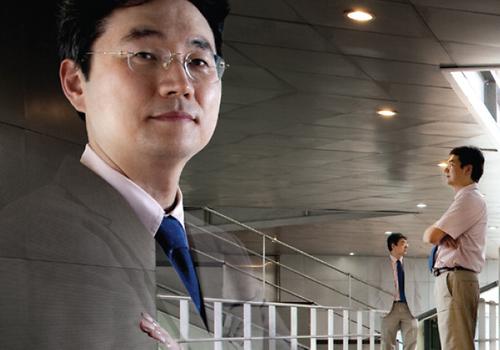
- Yonsei Develops World’s First Smart Invisibility Cloak
- The Optical Metamaterial Laboratory, led by Prof. Kim Kyoung-sik (Mechanical Engineering), is the world’s first to theoretically propose smart metamaterials and experimentally succeed with a smart invisibility cloak. Due to its use of material with heterogeneous structures in fixed condition, the existing invisibility cloak has shown a number of drawbacks, including losing its features, as with compression or tensile deformation, and taking long hard hours to make an invisibility cloak in a smaller size. The Laboratory’s recent study designed and produced a smart elastic photonic crystal structure that fulfills the unified changes of solid materials’ elastic deformation and optical metamaterials’optical deformation. This structure enables the production of an invisible cloak, maintaining the properties of the cloak regardless of its change in shape, as shown in science fiction films. The study also succeeded in creating the world’s first invisibility cloak made with a homogeneous photonic crystal structure. This has brought us a step closer to mass production of such a flexible largearea invisibility cloak. Their study, entitled “Broadband electromagnetic cloaking with smart metamaterials” (corresponding author: Prof. Kim Kyoung-sik; first author: Shin Dong-heok), was published on November 20, 2012 in the online edition of Nature Communications, a sister publication of the world’s leading scientific journal Nature. One of the co-authors of the study was Prof. David Smith (Duke University), the first to develop an invisibility cloak and refractive index metamaterials and who has been named in the media as a potential candidate for the Nobel Prize in Physics. Also, corresponding author Prof. Kim Kyoung-sik published a joint research article in Physical Review Letters in 2007 with that year’s Nobel Prize winner in Physics, Prof. David Wineland (United States National Institute of Standards and Technology, NIST). Prof. Kim Kyoung-sik said, “As a master’s and doctoral student, I majored in Particle Physics Theory and Optics. I got to apply elastic solid mechanics to optics as I began to work in Mechanical Engineering. I am very pleased to get such positive results.” He added, “Metamaterial technology can be variably applied to a wide range of such functional devices as optical lithography, stealth technology, optical material, thermal material, and high-efficiency energy material.
- 기계공학부 2020.06.27
-
6
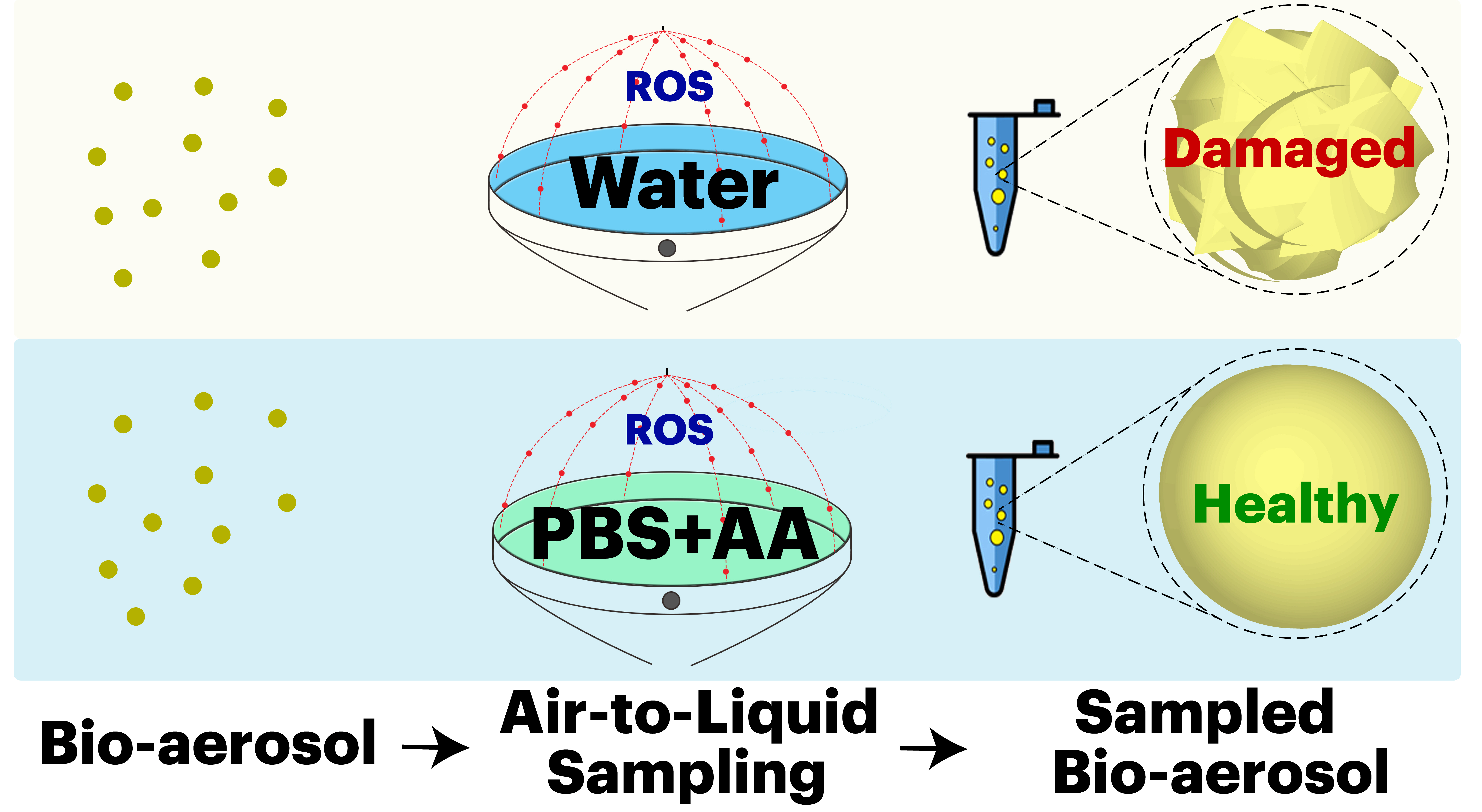
- Development of In-situ Air Samplers for Real-time Airborne Virus and Bacteria Monitoring
- Development of In-situ Air Samplers for Real-time Airborne Virus and Bacteria Monitoring A Yonsei research team, led by Professor Jungho Hwang in the school of Mechanical Engineering has been developing various techniques for real-time sampling of airborne pathogenic bioaerosols such as bacteria and virus. The air samplers are designed for an efficient collection of bioaerosols in either hydrosols or non-hydrosol-based platforms. The air samplers are integrated with various detection systems to provide rapid and accurate detection. The intracellular substance of bacteria collected by the air samplers reacts with a luminescent reagent to emit light, and the intensity of this light is proportional to the number of bacteria. The air samplers can also collect airborne viruses that are assayed using a commercial in-vitro diagnostic kit. The team has also elucidated an efficient technique for reducing the bioaerosols damage during aerosol-to-hydrosol sampling process. The results of these studies have been published in J. Hazardous Materials and Analytica Chimica Acta. According to Professor Hwang, “Bioaerosol sampling is crucial for environmental monitoring of hazardous airborne pathogens, which can contribute greatly to global health concerns and possibly prevent future pandemics.”
- 기계공학부 2020.06.08
-
5
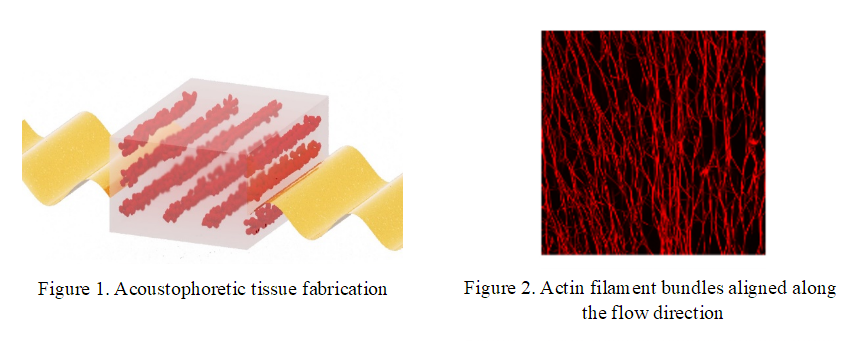
- High-resolution Acoustophoretic Engineering
- High-resolution Acoustophoretic Engineering Mechanobiology and Soft Material Laboratory at Yonsei University led by Prof. Hyungsuk Lee develops the acoustophoretic technique that apply to manipulate kinds of particles and cells. With the advantages of non-invasiveness, no need of label, and energy efficiency, the technique is able to select, pattern, mix, and translate micro-sized objects. Recently, the technique was used to fabricate a vascular tissue construct consisting of a biocompatible hydrogel and co-aligned multi-type cells in 3D patterns. The fabricated tissue replicating the tissue-specific cellular arrangement exhibited improvements in terms of differentiation, maturation, and anti-inflammation response of tissue. Implantation of the engineered tissue recovered the perfusion rate remarkably and rescued the ischemic tissue ultimately. The results of the research were published in Nature Communications with the title of “High-resolution acoustophoretic 3D cell patterning to construct functional collateral cylindroids for ischemia therapy”. The acoustophoretic technique can be further developed as a high-resolution bioprinting method to create any types of tissues, which are essential for tissue regeneration, therapeutic, and drug screening applications. 1. Kang B, Jo S, Baek J, Nakamura F, Hwang W, Lee H. Role of mechanical flow for actin network organization. Acta Biomaterialia, Vol. 90, P.217-24, 2019 2. Kang B, Shin J, Park HJ, Rhyou C, Kang D, Lee SJ, Yoon YS, Cho SW, Lee H. High-resolution acoustophoretic 3D cell patterning to construct functional collateral cylindroids for ischemia therapy. Nature Communications, Vol. 9, P. 5402, 2018
- 기계공학부 2020.06.08

